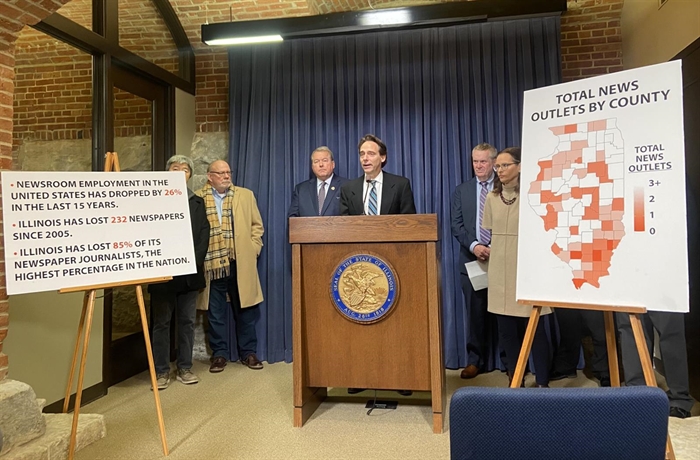Panel of experts suggest legislative measures to reverse journalism decline

A bipartisan task force of legislators and journalism industry leaders has filed a report to the General Assembly detailing the decline of local journalism in Illinois and exploring ways the legislature can help revive it.
The Local Journalism Task Force, created in January 2022, found that about one-third of Illinois counties have either no source of local news or a single source, citing research by the Northwestern University Medill School of Journalism.
Sen. Steve Stadelman, D-Rockford, said he plans to introduce a bill this session including some of the task force’s suggestions.
The policies recommended by the task force are a mix of strategies intended to increase funding, mitigate high operational costs and keep newsrooms local. Many of the recommendations have been implemented or introduced in other states.
The findings
The task force heard testimony and examined data and research from other experts and organizations around the state to create a final report detailing their findings and policy suggestions. Among its most startling discoveries is that one-third of Illinois’ newspapers have closed since 2005, creating an 86 percent decline in newspaper jobs over that span.
The report noted that as people consume more news online and local businesses are replaced by chains, subscription and advertising revenue decrease while operating costs – like buying paper and postage – continue to increase. The report said that means “people have taken the hit,” sometimes in the form of lay-offs to help outlets lower expenses.
Rural areas are most affected, but the report noted that news outlets in urban areas like Chicago are also affected. The Chicago Tribune’s staff decreased by 82 percent from 2006 to 2022, according to research by historian Jon Lauck. The task force also found broadcast outlets and outlets covering minority communities in urban areas are also struggling.
As a result of declining coverage, the task force said people in these underserved areas are missing out on crucial information.
“In too many towns, no one is covering local city council meetings,” Stadelman told reporters at a news conference. “No one is covering local school board meetings. So, how can residents know what’s going on?”
The report noted that with about 8,500 units of local government in the state, some offices might not comply with appropriate rules and regulations. The task force said journalists can help expose those situations and hold leaders accountable.
The task force cited a story about how The Harvey World Herald, “caught Harvey officials violating the open meetings act and prompted reform in that area.”
Recommendations
The task force suggested a series of tax credits that could give money back to people who subscribe to local outlets, small businesses that spend money advertising in local news, and outlets that pay journalists at least $50,000 a year.
The task force also suggested a tax exemption that would allow local outlets to not pay business and occupation taxes. A similar exemption was passed in Washington and took effect Jan. 1. Washington’s Office of Financial Management estimates the exemption will lower state revenue by $1.2 million when implemented for a full fiscal year, according to the report.
An “advertising set-aside” policy requiring a certain percentage of government advertising money be spent on advertising space in local media was also suggested by the task force. According to the report, $9.9 million of government advertising money was spent across 220 local outlets last year in New York City, which instituted a similar policy in 2019.
Other suggestions in the report include giving grant and fellowship programs state funding to help pay for journalist training and employment. Four states have implemented these strategies.
New Jersey’s grant consortium program, which funds a variety of local news programs, operates with $4 million in funding, of which $3 million comes from the state. California, New Mexico and Washington each work with local universities to place fellows in local newsrooms. California’s program is potentially the largest and most expensive of these, according to the report, with $25 million allocated to it with a goal of placing 120 fellows over the course of three years.
Other solutions proposed by the task force include incentives for large media companies to share their ad revenue with local media and incentives to donate closing news outlets to community organizations before they are purchased by larger national corporations.
Next steps
Task force member Sen. Donald DeWitte, R-St. Charles, shared concerns about mixing state-sponsored support and independent journalism. He said that legislators need to carefully consider any next steps to avoid infringing on free speech, influencing coverage and regulating the definition of journalism.
“I just want to be sure, particularly as we head into another election season here in Illinois … any decisions we make may have an effect on our constitutional liberties, and that they are being made for all the right reasons,” DeWitte said.
But Stadelman, who was previously a broadcast journalist in Rockford, said state involvement in news distribution is common, citing state public broadcasting subsidies and Europe’s support of its local news.
“I spent most of my life and career in news. I was skeptical of government involvement in news,” he said. “I think we’re at a point where there are ways that this can be done carefully and thoughtfully.”
Editor’s note: Two members of the Local Journalism Task Force – Sam Fisher and Jason Piscia – are also members of the Illinois Press Foundation board. The Press Foundation operates Capitol News Illinois and provides it funding.
Capitol News Illinois is a nonprofit, nonpartisan news service covering state government. It is distributed to hundreds of print and broadcast outlets statewide. It is funded primarily by the Illinois Press Foundation and the Robert R. McCormick Foundation, along with major contributions from the Illinois Broadcasters Foundation and Southern Illinois Editorial Association.
Miss Clipping Out Stories to Save for Later?
Click the Purchase Story button below to order a print of this story. We will print it for you on matte photo paper to keep forever.

